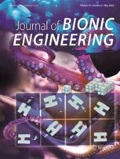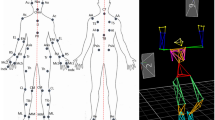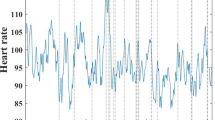Abstract
The purpose of this study was to develop a wavelet-based method to predict muscle forces from surface electromyography (EMG) signals in vivo. The weightlifting motor task was implemented as the case study. EMG signals of biceps brachii, triceps brachii and deltoid muscles were recorded when the subject carried out a standard weightlifting motor task. The wavelet-based algorithm was used to process raw EMG signals and extract features which could be input to the Hill-type muscle force models to predict muscle forces. At the same time, the musculoskeletal model of subject’s weightlifting motor task was built and simulated using the Computed Muscle Control (CMC) method via a motion capture experiment. The results of CMC were compared with the muscle force predictions by the proposed method. The correlation coefficient between two results was 0.99 (p<0.01). However, the proposed method was easier and more efficiency than the CMC method. It has potential to be used clinically to predict muscle forces in vivo.
Similar content being viewed by others
References
Rayment I, Holden H M, Whittaker M, Yohn C B, Lorenz M, Homes K C, Milligan R A. Structures of the actin-myosin complex and its implications for muscle contraction. Science, 1993a, 261, 58–65.
Viceconti M, Testi D, Taddel F, Martelli S, Clapworthy G J, Van Sint Jan S. Biomechanics modeling of the musculoskeletal apparatus: Status and key issues. Proceedings of the IEEE, 2006, 94, 725–739.
Pandy M G. Computer modeling and simulation of human movement. Annual Review of Biomedical Engineering, 2001, 3, 245–273.
Erdemir A, McLean S, Herzog W, van den Bogert A J. Model-based estimation of muscle forces exerted during movements. Clinic Biomechanics, 2007, 22, 131–154.
Yamaguchi G T. Dynamic Modeling of Musculoskeletal Motion: a Vectorized Approach for Biomechanical Analysis in Three Dimensions, Springer, New York, USA, 2006.
Kaufman K R. Future directions in gait analysis. Journal of Rehabilitation Research and Development, Monograph, 1998, 2, 85–112.
McGill S M, Norman R W. Dynamically and statically determined low back moments during lifting. Journal of Biomechanics, 1985, 18, 877–885.
Koning J J, de Groot G, van Ingen Schenau G J. Speed skating the curves: A study of muscle coordination and power production. International Journal of Sport Biomechanics, 1991, 7, 344–358.
Stefanyshyn D J, Nigg B M. Contributions of the lower extremity joints to mechanical energy in running vertical and running long jumps. Journal of Sports Sciences, 1998, 16, 177–186.
Hardt D E. Determining muscle forces in the leg during normal human walking — an application and evaluation of optimization methods. Journal of Biomechanical Engineering, 1978, 100, 72–78.
Pandy M G, Zajac F E, Sim E, Levine W S. An optimal control model for maximum-height human jumping. Journal of Biomechanics, 1990, 23, 1185–1198.
Pandy M G, Anderson F C, Hull D G. A parameter optimization approach for the optimal control of large-scale musculoskeletal systems. Journal of Biomechanical Engineering, 1992, 114, 450–460.
Anderson F C, Pandy M G. A dynamic optimization solution for vertical jumping in three dimensions. Computer Methods in Biomechanics and Biomedical Engineering, 1999, 2, 201–231.
Yamaguchi G T, Zajac F E. Restoring unassisted natural gait to paraplegics via functional electrical stimulation: a computer simulation study. IEEE Transactions on Biomedical Engineering, 1990, 37, 886–902.
Anderson F C, Pandy M G. Dynamic optimization of human walking. Journal of Biomechanical Engineering, 2001, 123, 381–390.
Kaplan M L, Heegaard J H. Predictive algorithms for neuromuscular control of human locomotion. Journal of Biomechanics, 2001, 34, 1077–1083.
Seth A, Pandy M G. A neuromusculoskeletal tracking method for estimating individual muscle forces in human movement. Journal of Biomechanics, 2007, 40, 356–366.
Thelen D G, Anderson F C, Delp S L. Generating dynamic simulations of movement using computed muscle control. Journal of Biomechanics, 2003, 36, 321–328.
Delp S L, Anderson F C, Arnold A S, Loan P, Habib A, John C T, Guendelman E, Thelen D G. OpenSim: Open-source software to create and analyze dynamic simulations of movement. IEEE Transactions on Biomedical Engineering, 2007, 54, 1940–1950.
Yan Z, Wang Z, Xie H. Joint application of rough set-based features reduction and Fuzzy LS-SVM classifier in motion classificatio. Medical and Biological Engineering and Computing, 2008, 46, 519–527.
Basmajian J V, De Luca C J. Muscle Alive: Their Functions Revealed by Electromyography, Williams & Wilkins Press, Baltimore, USA, 1985.
Sparto P J, Parnianpour M, Barria E A, Jagadeesh J M. Wavelet and short-time fourier transform analysis of electromyography for detection of back muscle fatigue. IEEE Transactions on Rehabilitation Engineering, 2000, 8, 433–436.
Boyd S K, Herzog W, Nigg B. Biomechanics of the musculoskeletal system, Wiley Press, Chichester, UK, 2007.
Nussbaum M A, Chaffin D B. Lumbar muscle force estimation using a subject-invariant 5-parameter EMG-based model. Journal of Biomechanics, 1998, 31, 667–672.
Buchanan T S, Delp S L, Solbeck J A. Muscular resistance to varus and valgus loads at the elbow. Journal of Biomechanical Engineering, 1998, 120, 634–639.
Laursen B, Jenson B R, Nemeth G, Sjogaard G. A model predicting individual shoulder muscle forces based on relationship between electromyographic and 3D external forces in static position. Journal of Biomechanics, 1998, 31, 731–739.
Piazza S J, Delp S L. The influence of muscles on knee flexion during the swing phase of gait. Journal of Biomechanics, 1996, 29, 723–733.
Hof A L, Van den Berg Jw. EMG-to-force processing. II: Estimation of parameters of the Hill Muscle model for the human triceps surae by means of calf ergometer. Journal of Biomechanics, 1981a, 14, 759–770.
Hof A L, Van den Berg Jw. EMG-to-force processing. III: Estimation of model parameters for the human triceps surae muscle and the assessment of the accuracy by means of a torque plate. Journal of Biomechanics, 1981b, 14, 771–785.
Wu M, Qie J, Gu Q. Wavelet package-neural network based on rough set diesel engine vibration signal identification model. Proceedings of the 2003 International Conference on Neural Networks and Signal Processing, 2003, 12, 185–190.
Mallat S. A theory for multiresolution signals decomposition: The wavelet representation. IEEE Transactions on Pattern Analysis and Machine Intelligence, 1989, 11, 674–693.
Akay M. Wavelet application in medicine. IEEE Spectrum Magazine, 1997, 34, 50–56.
Li S. The Theory and Method of Sports Biomechanics, China Science Press, Beijing, China, 2006. (in Chinese)
Hill A V. The heat of shortening and the dynamic constants of muscle. Proceedings of the Royal Society B, 1938, 126, 136–195.
Zajac F E. Muscle and tendon: properties, models, scaling, and application to biomechanics and motor control. Critical Reviews in Biomedical Engineering, 1989, 17, 359–411.
Hodgson J A. The relationship between soleus and gastrocnemius muscle activity in conscious cats: A model for motor unit recruitment. Journal of Physiology, 1983, 337, 553–562.
Holzbaur K R, Murray W M, Delp S L. A model of the upper extremity for simulating musculoskeletal surgery and analyzing neuromuscular control. Annals of Biomedical Engineering, 2005, 33, 829–840.
Pennestri E, Stefanelli R, Valentini P P, Vita L. Virtual musculoskeletal model for the biomechanical analysis of the upper limb. Journal of Biomechanics, 2007, 40, 1350–1361.
Percival D B, Walden A T. Wavelet Methods for Time Series Analysis, Cambridge Press, Cambridge, UK, 2000.
Suter B W. Multirate and Wavelet Signal Processing, Academic Press, San Diego, USA, 1998.
Daubechies I. Ten Lectures on Wavelets, SIAM, Philadelphia, USA, 1992.
Mallat S G. A Wavelet Tour of Signal Processing, Academic Press, San Diego, USA, 1998.
Karlsson S, Gerdle B. Mean frequency and signal amplitude of the surface EMG of the quadriceps muscles increase with increasing torque-a study using the continuous wavelet transform. Journal of Electromyography and Kinesiology, 2001, 11, 131–140.
Karlsson J S, Ostlund N, Larsson B, Gerdle B. An estimation of the influence of force decrease on the mean power spectral frequency shift of the EMG during repetitive maximum dynamic knee extensions. Journal of Electromyography and Kinesiology, 2003, 13, 461–468.
Bogey R A, Perry J, Gitter A J. An EMG-to-force processing approach for determining ankle muscle forces during normal human gait. IEEE Transactions on neural system and rehabilitation engineering, 2005, 13, 302–310.
Lloyd D G, Besier T F. An EMG-driven musculoskeletal model to estimate muscle forces and knee joint moments in vivo. Journal of Biomechanics, 2003, 36, 765–776.
Potvin J R, Norman R W, McGill S M. Mechanically corrected EMG for the continuous estimation of erector spinae muscle loading during repetitive lifting. European Journal of Applied Physiology and Occupational Physiology, 1996, 74, 119–132.
Van den Bogert A J, Gerritsen K G M, Cole G K. Human muscle modeling from a user’s perspective. Journal of Electromyography and Kinesiology, 1998, 8, 119–124.
Epstein M, Herzog W. Theoretical Models of Skeletal Muscle, Wiley, New York, USA, 1998.
Schutte L M, Rodgers M M, Zajac F E. Improving the efficacy of electrical simulation-induced leg cycle ergometry: an analysis based on a dynamic musculoskeletal model. IEEE Transactions on Rehabilitation Engineering, 1993, 1, 109–125.
Hermens H J, Freriks B, Disselhorst-Klug C, Rau G. Development of recommendations for SEMG sensors and sensor placement procedures. Journal of Electromyography and Kinesiology, 2000, 10, 361–374.
Langenderfer J, Jerabek S A, Thangamani V B, Kuhn J E, Hughes R E. Musculoskeletal parameters of muscles crossing the shoulder and elbow and the effect of sarcomere length sample size on estimation of optimal muscle length. Clinical Biomechanics, 2004, 19, 664–670.
Author information
Authors and Affiliations
Corresponding author
Rights and permissions
About this article
Cite this article
Wei, G., Tian, F., Tang, G. et al. A Wavelet-Based Method to Predict Muscle Forces From Surface Electromyography Signals in Weightlifting. J Bionic Eng 9, 48–58 (2012). https://doi.org/10.1016/S1672-6529(11)60096-6
Published:
Issue Date:
DOI: https://doi.org/10.1016/S1672-6529(11)60096-6




